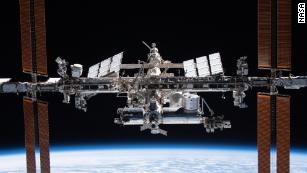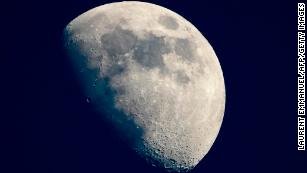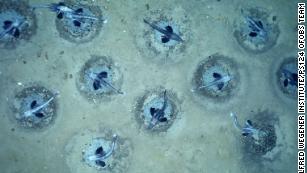#ECOCIDE POISIONING THE PLANET
This is the space graveyard where the International Space Station will be buriedBy Katie Hunt, CNN
Sun February 6, 2022

(CNN)Three thousand miles off the coast of New Zealand and 2,000 miles north of Antarctica, Point Nemo is so far from land that the closest humans are often the astronauts on board the International Space Station -- that orbits 227 nautical miles above Earth.

(CNN)Three thousand miles off the coast of New Zealand and 2,000 miles north of Antarctica, Point Nemo is so far from land that the closest humans are often the astronauts on board the International Space Station -- that orbits 227 nautical miles above Earth.
It's precisely this remoteness that explains why the ISS, once it's retired in 2030, will end its days here, plummeting to Earth to join other decommissioned space stations, satellites and space debris. This is the world's space graveyard.
Spacefaring nations have been dumping their junk in the area around Point Nemo, named after Captain Nemo from Jules Verne's novel "Twenty Thousand Leagues Under The Sea," since the 1970s.

NASA plans to retire the International Space Station by 2031 by crashing it into the Pacific Ocean
Also known as the Oceanic Pole of Inaccessibility or South Pacific Ocean Uninhabited Area, the exact coordinates of the world's most remote spot were calculated by Canadian-Russian engineer Hrvoje Lukatela in 1992.
More than 263 pieces of space debris have been sunk in this area since 1971, including Russia's Mir space station and NASA's first space station Skylab, according to a 2019 study. They're not intact monuments to the history of space travel but are likely fragmented debris scattered over a large area.
"This is the largest ocean area without any islands. It is just the safest area where the long fall-out zone of debris after a re-entry fits into," said Holger Krag, Head of the Space Safety Programme Office at the European Space Agency.
Point Nemo is beyond any state's jurisdiction and is devoid of any human life -- although it's not free from the traces of human impact. In addition to the space junk on the seafloor, microplastic particles were discovered in the waters when yachts in the Volvo Ocean Race passed through the region in 2018.
Best practice
Space junk such as old satellites reenter the Earth's atmosphere on a daily basis, although most of it goes unnoticed because it burns up long before it can hit the ground.
It's only larger space debris -- such as spacecraft and rocket parts -- that pose a very small risk to humans and infrastructure on the ground. Space agencies and operators must plan well in advance to ensure that it falls to Earth in this far-flung bit of ocean.
In the case of the International Space Station, NASA said the ISS will begin maneuvers to prepare for deorbit as early as 2026, lowering the altitude of the space lab, with it expected to crash back to Earth in 2031. The exact timings of the maneuvers depends on the solar cycle activity and its effect on Earth's atmosphere.
"Higher solar activity tends to expand the Earth's atmosphere and increase resistance to the ISS' velocity, resulting in more drag and natural altitude loss," NASA said in a newly published document outlining plans for decommissioning the ISS.
Space agencies and commercial operators must also notify authorities in control of flights and shipping -- usually in Chile, New Zealand and Tahiti -- of the location, timing and dimensions of the debris fall-out zones. Around two flights per day pass through the air space, said Krag. These authorities produce standardized message sent out to air and sea traffic.
A bigger problem than the spacecraft that end up in Point Nemo, said Krag, is chunks of metal rocket stages and spacecraft making what's known as an "uncontrolled reentry" into the Earth's atmosphere.

A rocket booster could crash into the moon in the next few weeks
In June 2021, NASA criticized China for failing to "meet responsible standards" after debris from its out-of-control Long March 5B rocket plunged into the Indian Ocean.
"Spacefaring nations must minimize the risks to people and property on Earth of re-entries of space objects and maximize transparency regarding those operations," said NASA Administrator Bill Nelson at the time.
The rocket, which was about 108 feet tall and weighed nearly 40,000 pounds, had launched a piece of a new Chinese space station into orbit on April 29. After its fuel was spent, the rocket had been left to hurtle through space uncontrolled until Earth's gravity dragged it back to the ground.
Krag said that, on average, 100 to 200 tons of space junk reenter the Earth's atmosphere in an uncontrolled way every year, yet most space experts consider reentry the most desirable outcome for space junk.
The vast majority stays above us where it can collide with functioning satellites, create more junk and threaten human life on crewed spacecraft.
There are at least 26,000 pieces of space junk orbiting the Earth that are the size of a softball or larger and could destroy a satellite on impact; over 500,000 the size of a marble big enough to cause damage to spacecraft or satellites; and over 100 million pieces of debris the size of a grain of salt that could puncture a spacesuit, according to a NASA report issued last year.
Ocean trash can?
Landing space junk in the ocean depths of Point Nemo is the least worst option, said Vito De Lucia, a professor of law at the Norwegian Centre for the Law of the Sea at The Arctic University of Norway. However, we don't know much about the deep sea environment in this area.
Some research suggests that because of ocean currents in that region -- known as the South Pacific Gyre -- it is not particularly biologically diverse. Oceanographer Autun Purser, a postdoctoral researcher at the Alfred Wegener Institute in Bremerhaven, Germany, said he had been close the area and said the seafloor would likely be inhabited with sea cucumbers, seabed octopuses and "the odd fish."
"There is generally a low reign of food, as it is in the middle of the Pacific Gyre, a low productivity area with little upwelling nutrient rich waters, so though there will be seafloor animals, there will not be a high biomass down there probably," he said via email.
Krag at the European Space Agency said that the space objects that landed in the ocean were typically made from stainless steel, titanium or aluminum and were not toxic.
"It is not more than a few dozens of metric tons per year. The re-entering fragments do not float, but sink and therefore are no hazard to ship traffic. Compared to the many lost containers and sunk ships, the amount of space hardware is vanishingly small."
He noted that some rocket fuels are toxic but that they burn up during re-entry.
Krag said that ESA was working on what he termed "design-for-demise" technology that would replace the aluminum, titanium and steel with materials that would melt during reentry.
International Space Station to Join Rest of Humanity’s Garbage at Bottom of the Ocean
Who lives in a space station under the sea?
By Chelsea Steiner
But de-orbiting the ISS will still be challenging, as it is the largest man-made object ever to occupy low-Earth orbit. Past uncontrolled deorbits have seen a scattering of space station parts across the ocean. And in 1979, the uncontrolled deorbit of NASA’s Skylab space station rained debris across Australia. No one was hurt, and Skylab became a pop culture punchline.
(via NBC News, image: NASA)
Who lives in a space station under the sea?
By Chelsea Steiner
Feb 5th, 2022,

NASA has announced that the International Space Station (ISS) will be retired in January 2031, at which point it will crash land into the ocean. The orbiting laboratory, which launched in 1998, will splash down at Point Nemo, a remote spot in the Pacific Ocean that is 1,678 miles from land, has been the site of many defunct satellites and man-made space detritus, earning it the nickname the “spacecraft cemetery”.
The ISS was a collaboration between NASA, the European Space Agency, Russia’s Roscosmos space program, the Canadian Space Agency and the Japan Aerospace Exploration Agency. Orbiting 227 nautical miles above Earth, the ISS has seen more than 200 astronauts from 19 different countries come aboard.
But NASA still has plans for the next decade of ISS. “The International Space Station is entering its third and most productive decade as a groundbreaking scientific platform in microgravity,” said Robyn Gatens, director of the International Space Station at NASA. “This third decade is one of results, building on our successful global partnership to verify exploration and human research technologies to support deep space exploration, continue to return medical and environmental benefits to humanity, and lay the groundwork for a commercial future in low-Earth orbit.”
Gatens added, “We look forward to maximizing these returns from the space station through 2030 while planning for transition to commercial space destinations that will follow.” Commercial space stations and space travel is clearly the wave of the future, as is the long heralded arrival of space tourism (for the obscenely wealthy at least).
“The private sector is technically and financially capable of developing and operating commercial low-Earth orbit destinations, with NASA’s assistance. We look forward to sharing our lessons learned and operations experience with the private sector to help them develop safe, reliable, and cost-effective destinations in space,” said Phil McAlister, director of commercial space at NASA Headquarters. “The report we have delivered to Congress describes, in detail, our comprehensive plan for ensuring a smooth transition to commercial destinations after retirement of the International Space Station in 2030.”

NASA has announced that the International Space Station (ISS) will be retired in January 2031, at which point it will crash land into the ocean. The orbiting laboratory, which launched in 1998, will splash down at Point Nemo, a remote spot in the Pacific Ocean that is 1,678 miles from land, has been the site of many defunct satellites and man-made space detritus, earning it the nickname the “spacecraft cemetery”.
The ISS was a collaboration between NASA, the European Space Agency, Russia’s Roscosmos space program, the Canadian Space Agency and the Japan Aerospace Exploration Agency. Orbiting 227 nautical miles above Earth, the ISS has seen more than 200 astronauts from 19 different countries come aboard.
But NASA still has plans for the next decade of ISS. “The International Space Station is entering its third and most productive decade as a groundbreaking scientific platform in microgravity,” said Robyn Gatens, director of the International Space Station at NASA. “This third decade is one of results, building on our successful global partnership to verify exploration and human research technologies to support deep space exploration, continue to return medical and environmental benefits to humanity, and lay the groundwork for a commercial future in low-Earth orbit.”
Gatens added, “We look forward to maximizing these returns from the space station through 2030 while planning for transition to commercial space destinations that will follow.” Commercial space stations and space travel is clearly the wave of the future, as is the long heralded arrival of space tourism (for the obscenely wealthy at least).
“The private sector is technically and financially capable of developing and operating commercial low-Earth orbit destinations, with NASA’s assistance. We look forward to sharing our lessons learned and operations experience with the private sector to help them develop safe, reliable, and cost-effective destinations in space,” said Phil McAlister, director of commercial space at NASA Headquarters. “The report we have delivered to Congress describes, in detail, our comprehensive plan for ensuring a smooth transition to commercial destinations after retirement of the International Space Station in 2030.”
But de-orbiting the ISS will still be challenging, as it is the largest man-made object ever to occupy low-Earth orbit. Past uncontrolled deorbits have seen a scattering of space station parts across the ocean. And in 1979, the uncontrolled deorbit of NASA’s Skylab space station rained debris across Australia. No one was hurt, and Skylab became a pop culture punchline.
(via NBC News, image: NASA)


No comments:
Post a Comment